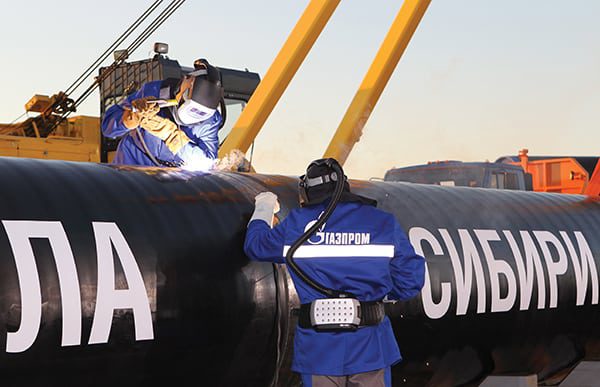Construction of Russia-China Pipeline Kicks Off
Gazprom on Sept. 1 made the first weld of a 4,000-km natural gas pipeline that will run from gas production centers in Russia’s Yakutia and Irkutsk gas production fields to Russia’s Far Eastern regions and, for the first time, to China.
The “Power of Siberia” (“Sila Sibiri” in Russian) gas transmission system is part of Russia’s plans to build a modern gas network that connects its remote western Siberia region and the Far East with the country’s Unified Gas Supply System.
At the same time, Gazprom is looking to implement a May 2014–signed purchase and sale agreement for Russian gas supplies to China. That 30-year contract—valued at $400 billion—will see the supply of 38 billion cubic meters (bcm) of gas per year to energy-hungry China—or over one trillion cubic meters (tcm) during the whole contractual period.
It will mean laying 1.7 billion tons of pipes between 2014 and 2018 amid complex geological and climatic conditions, spanning five Russian regions (Figure 4). It will start from the Chayanda oil and gas field in the Arctic region of Yakutia (which will begin production in 2015 and has gas reserves of 1.2 tcm), then run within an integrated corridor with the second stage of the Eastern Siberia-Pacific Ocean oil pipeline. In Khabarovsk, a city about 30 km from the Chinese border, the pipeline will be connected to the 2011-opened Sakhalin-Khabarovsk-Vladivostok pipeline, which transports gas to Russia’s Far East. Gazprom envisions the pipeline being connected to Blagoveshchensk, on the Russian-Chinese border, by 2018.
The pipeline, which will be the longest in the world when completed, will cost $20 billion to build. It will also require innovative engineering concepts and technologies, including pipeline monitoring systems. “Among such applications are [domestically] manufactured longitudinally welded pipes made of cold resistant steel K60 with external anti-corrosion and smooth internal coating, 1,420 mm in diameter and 21.7 mm of wall thickness, designed for 100 Ata operating pressure,” Gazprom said. “In the areas of tectonic faults and intense seismic activity higher than eight points the [pipeline] will be made of high-strength pipes.”
Some experts suggest that when operational, the pipeline will mark a clear shift in the world’s natural gas trade. Russia has an imperative to diversify its exports away from Europe owing to slack demand and the conflict in Ukraine, through which almost half of supplies to the continent flow.
Russian gas flows have been stopped three times in the past decade—in 2006, 2009, and in 2014—stemming from price disputes with Ukraine. But threats that Russia could halt gas supplies this winter have meanwhile lost their bite. European Union (EU) Energy Commissioner Guenther Oettinger told reporters on Aug. 27 that the EU has a “Plan B for the worst-case scenario. But we don’t expect to need it,” he said. He noted that European power and gas providers have been storing as much gas as possible over low demand periods.
At the same time, China’s gas demand has tripled since 2006, while imports have surged from less than 1 bcm in 2006 to 53 bcm in 2013. The country’s government in April said that it will more than double natural gas consumption, from 170 bcm in 2013 to 400 bcm to 420 bcm in 2020. For China, the pipeline means greater natural gas security, a more diversified import portfolio, and more supplies of a fuel it could use to mitigate the country’s air-quality troubles.
—Sonal Patel is a POWER associate editor (@POWERmagazine, @sonalcpatel)
